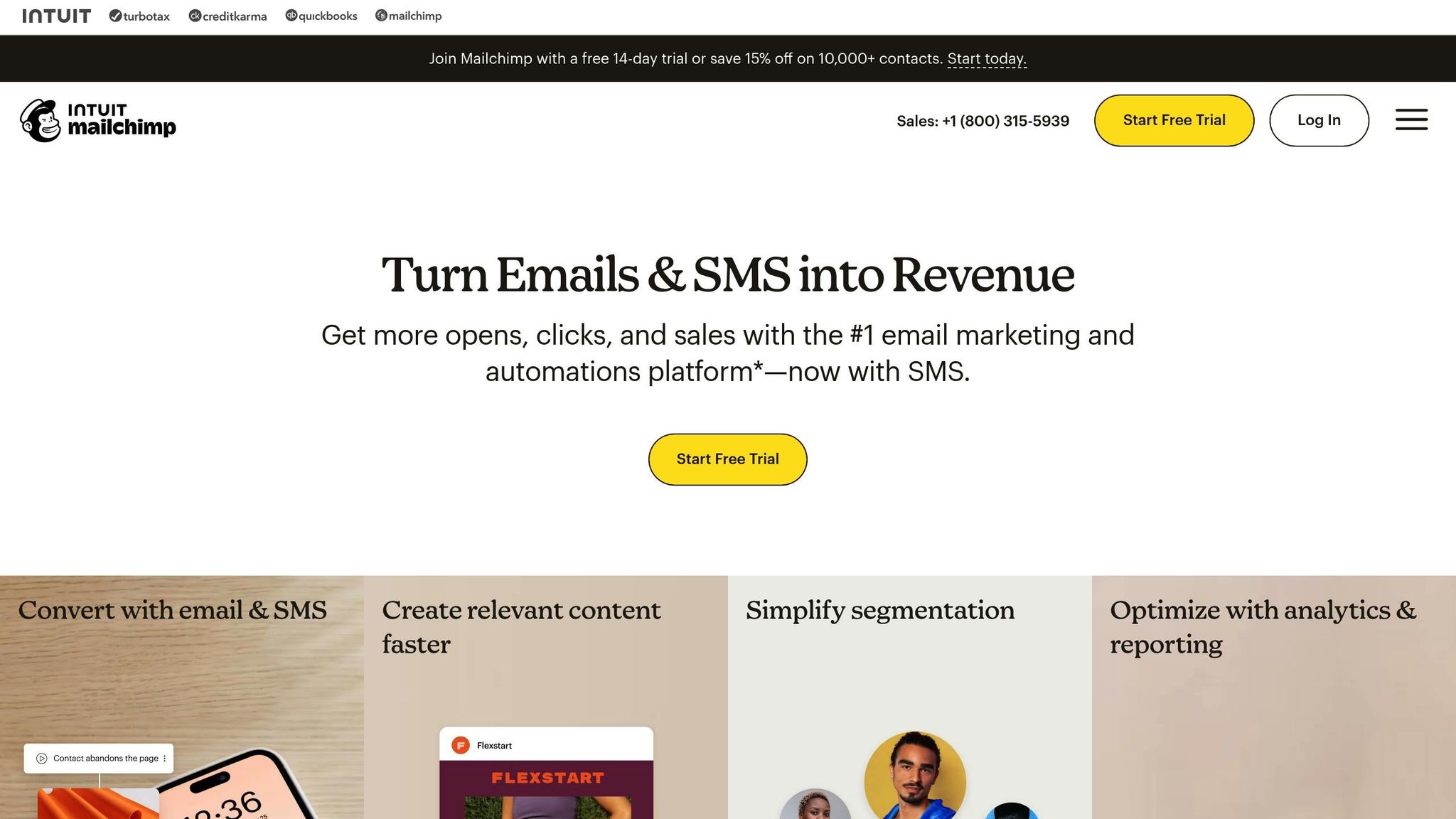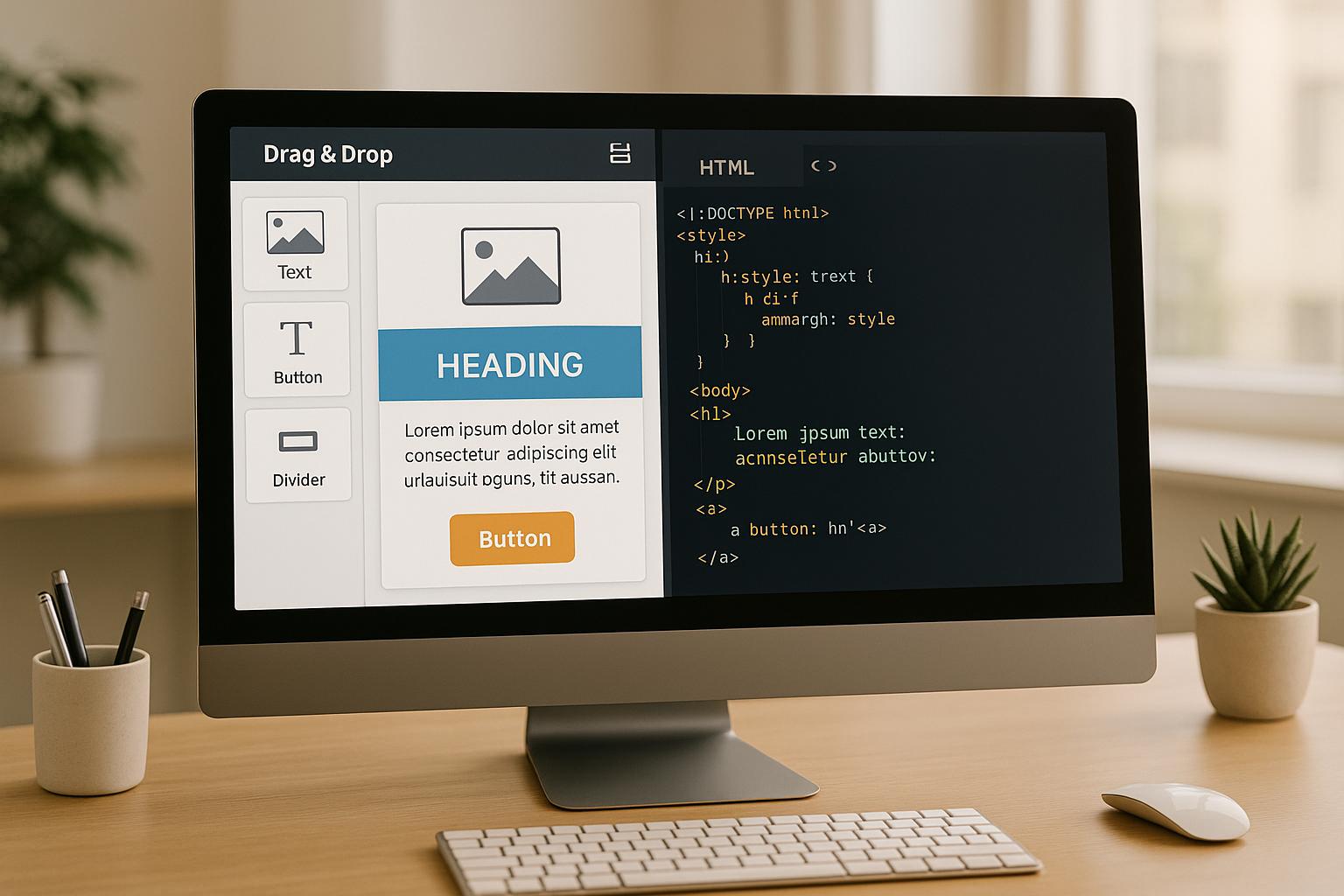Did you know? Over 75% of people delete emails that are hard to read, and emails with proper font styling can increase click-through rates by 30%. Plus, consistent typography can boost revenue by up to 23%.
Here’s why email font styling matters and how to fix common issues:
- Why It’s Important: Clear, readable fonts enhance engagement, reinforce brand identity, and improve accessibility for all users, including the 15% of recipients with disabilities.
- Common Problems: Fonts not loading, size inconsistencies, and unwanted font changes (like Outlook switching to Times New Roman).
- Quick Fixes:
- Use fallback fonts (e.g.,
Arial, Helvetica, sans-serif). - Apply inline CSS for consistency.
- Add conditional comments for tricky clients like Outlook.
- Follow accessibility standards (minimum 14px font size, 4.5:1 contrast ratio).
- Use fallback fonts (e.g.,
Quick Comparison of Email Client Font Support
| Email Client | Custom Font Support | Fallback Behavior |
|---|---|---|
| Outlook Desktop | Limited | Defaults to Times New Roman |
| Gmail (Web/Mobile) | Yes (via @import) |
Sans-serif default |
| Apple Mail (iOS) | Full support | Helvetica |
| Android Mail | Yes (via @import) |
Sans-serif default |
Fix Mailchimp Incorrectly Formatted Text [Solved]

Font Display Problems Across Email Clients
Dealing with email font issues requires a solid grasp of how different clients handle rendering. Each email client has its quirks, thanks to the variety of rendering engines in use. Let’s break down some common font display problems and how to address them.
Web Font Loading Failures
Sometimes, web fonts just don’t load in certain email clients. When this happens, the email automatically switches to the next font in the stack. A common example is Outlook, which skips over custom web fonts and defaults to a system font instead. For example:
font-family: 'Open Sans', Arial, sans-serif;
In cases like this, having a well-thought-out font stack ensures your email still looks professional, even if the primary font doesn’t load.
Font Size Display Differences
Font sizes can appear differently depending on the device or email client, which directly impacts readability:
| Device Type | Issue | Cause |
|---|---|---|
| Desktop | Fonts may appear smaller | Client-specific rendering engines |
| Mobile | Fonts are resized automatically | Variations in screen density |
| Tablets | Scaling can be inconsistent | Viewport adjustments |
For example, a font set at 16px might display as 14px or even 18px on mobile devices, depending on the client’s settings. Mobile email clients often resize fonts to improve readability, but this can result in unexpected changes.
Sans-Serif to Serif Font Changes
Outlook is notorious for swapping out specified sans-serif fonts with serif defaults like Times New Roman. This happens because Outlook relies on the Microsoft Office Word engine for rendering. To reduce this issue, you can reorder your font stack like this:
font-family: Arial, Helvetica, sans-serif, 'Open Sans';
How to Fix Common Font Problems
Here’s how to tackle font consistency issues across different email clients with practical solutions.
Setting Up Font Fallbacks
To ensure smooth font rendering, structure your font stacks effectively. Use examples like:
font-family: 'Open Sans', Arial, Helvetica, sans-serif !important;
or:
font-family: Arial, Helvetica, sans-serif, 'Open Sans';
For more precise control, apply conditional comments:
<!--[if !mso]><!-->
<style>
.custom-font { font-family: 'Open Sans', Arial, sans-serif; }
</style>
<!--<![endif]-->
<!--[if mso]>
<style>
.custom-font { font-family: Arial, sans-serif; }
</style>
<![endif]-->
This approach ensures fallback fonts are properly applied, even in email clients with limited font support.
Using Inline CSS for Font Control
Inline CSS is a reliable way to maintain font consistency. Here’s an example:
<p style="font-family: Arial, Helvetica, sans-serif; font-size: 14px; color: #333333; line-height: 1.5;">Your content here</p>
For critical elements, use !important to guarantee priority:
<span style="font-family: Arial, Helvetica, sans-serif !important; font-size: 16px !important;">Important text</span>
Here’s a quick reference for key inline properties:
| Property | Recommended Value | Why It Works |
|---|---|---|
| font-size | 14px-16px | Ensures readability across devices |
| line-height | 1.5 | Provides comfortable text spacing |
| color | #333333 | Offers good contrast without being harsh |
Combining these inline styles with fallback strategies creates a robust solution for consistent font rendering.
Outlook-Specific Font Fixes
Outlook often requires additional tweaks. Use conditional comments like this:
<!--[if mso]>
<style>
.body-text {
font-family: Arial, sans-serif !important;
font-size: 14px !important;
}
h1 {
font-family: Georgia, serif !important;
font-size: 24px !important;
}
</style>
<![endif]-->
For non-Outlook clients, you can still load web fonts with this method:
<!--[if !mso]><!-->
<link href="https://fonts.googleapis.com/css?family=Open+Sans:400,700" rel="stylesheet">
<!--<![endif]-->
sbb-itb-6e7333f
Making Fonts Accessible in Emails
Ensuring font accessibility in emails isn't just about avoiding display issues - it’s about making your content readable and inclusive for everyone. By choosing the right fonts and formatting, you can create emails that work for all readers.
Choosing Clear, Readable Fonts
When picking fonts, clarity and legibility should guide your choices. According to the Web Content Accessibility Guidelines (WCAG), fonts with distinct letterforms and proper spacing are essential for accessibility.
Here’s a quick guide to accessible font options:
| Font Type | Recommended Fonts | Best Use Cases |
|---|---|---|
| Sans-serif | Verdana, Arial | Body text, smaller sizes |
| Serif | Georgia, Times New Roman | Headlines, larger text |
| System | Tahoma, Helvetica | Navigation, buttons |
Font size matters too:
- Body text should be at least 14px to ensure readability.
- Headlines should start at 22px or larger.
- Navigation links should be no smaller than 16px.
Here’s an example of accessible font implementation:
<div style="font-family: Verdana, Arial, sans-serif; font-size: 14px; line-height: 1.5;">
Main content text
</div>
<h1 style="font-family: Georgia, Times New Roman, serif; font-size: 24px;">
Headline text
</h1>
After selecting fonts, focus on color contrast between text and background for better readability.
Text and Background Contrast
Contrast is key when it comes to making text stand out against its background. WCAG sets specific contrast ratio guidelines to ensure readability:
- Normal text: Minimum contrast ratio of 4.5:1
- Large text (18px or larger): Minimum contrast ratio of 3:1
Here are some compliant color combinations:
| Text Color | Background Color | Contrast Ratio | Compliance |
|---|---|---|---|
| #000000 (Black) | #FFFFFF (White) | 21:1 | Passes AAA |
| #1A237E (Navy) | #FAFAFA (Off-white) | 16:1 | Passes AAA |
| #FFFFFF (White) | #2E7D32 (Green) | 4.6:1 | Passes AA |
Here’s an example of applying high-contrast colors:
<div style="color: #000000; background-color: #FFFFFF; font-family: Verdana, sans-serif;">
High-contrast text example
</div>
To ensure your email meets these standards, use contrast-checking tools. Many email marketing platforms now offer built-in accessibility testing features, helping you create campaigns that are not only compliant with WCAG but also polished and professional.
Email Client Font Support Guide
Making sure your email looks good across different platforms depends heavily on understanding how email clients handle fonts. Here's a detailed guide to help you navigate font support for various email clients.
Font Support by Email Client
Here’s a snapshot of how major email clients handle fonts:
| Email Client | Supported Web-Safe Fonts | Custom Font Support | Fallback Behavior |
|---|---|---|---|
| Outlook Desktop | Arial, Calibri, Times New Roman | Limited | Defaults to Times New Roman |
| Gmail Web | Arial, Roboto, Helvetica | Yes, via @import | Sans-serif default |
| Apple Mail | San Francisco, Helvetica | Full support | Helvetica |
| Outlook.com | Calibri, Segoe UI | Partial | Arial |
| iOS Mail | San Francisco, Helvetica | Full support | Helvetica |
| Android Mail | Roboto, Noto Sans | Yes, via @import | Sans-serif default |
Key Behaviors and Tips for Specific Clients
Outlook Desktop (2007–2013)
When using custom fonts, Outlook Desktop can sometimes default to Georgia unexpectedly. To avoid this, structure your font stack carefully, like so:
font-family: Arial, 'Your Custom Font', sans-serif;
Gmail Web and Mobile
Gmail supports web fonts through @import rules, but each font weight requires its own import. For example:
@import url('https://fonts.googleapis.com/css2?family=Open+Sans:wght@400;700&display=swap');
Apple Mail and iOS Mail
These clients offer excellent font support, handling both system and web fonts seamlessly. If your chosen font isn’t available, they’ll fallback to Helvetica.
Recommended Web-Safe Font Combinations
For consistency across platforms, use these tried-and-true font pairings:
| Primary Font | Windows Equivalent | macOS Equivalent |
|---|---|---|
| Arial | Arial | Helvetica |
| Times New Roman | Times New Roman | Times |
| Trebuchet MS | Trebuchet MS | Trebuchet MS |
| Verdana | Verdana | Geneva |
| Courier New | Courier New | Courier |
Implementation Best Practices
To ensure your fonts display correctly, use inline CSS for email templates. This approach works across most email clients:
<div style="font-family: Arial, Helvetica, sans-serif; font-size: 14px;">
Your email content here
</div>
Testing and Compatibility
Testing has shown that CSS3 font declarations work well in clients like Thunderbird, Mac Mail, iOS, and Windows Phone. However, for the broadest compatibility, stick to basic font declarations with reliable fallback fonts. This ensures your email remains readable no matter where it’s viewed.
Conclusion: Best Practices for Email Fonts
To create polished and effective email designs, focus on two key factors: compatibility and readability. Using web-safe fonts paired with reliable fallbacks guarantees consistent appearance across various platforms and devices. For example, inline CSS declarations like font-family: Arial, Helvetica, sans-serif help maintain uniform styling across email clients.
For readability, stick to a minimum font size of 14px for body text and 22px for headings. Pair this with line heights between 1.4 and 1.6 to ensure text remains clear and easy to read, regardless of the device. Outlook, infamous for its rendering quirks, can be managed by carefully structuring your font stack to avoid unexpected defaults:
font-family: Arial, 'Your Custom Font', sans-serif;
This approach minimizes issues and ensures a consistent user experience.
Additionally, platforms highlighted in the Email Service Business Directory offer tools for testing font support, making it easier to address client-specific challenges. High contrast ratios and clean, easy-to-read typefaces can noticeably improve engagement and overall user experience.
When incorporating custom web fonts, always include dependable fallback options and test thoroughly in major email clients like Gmail and Outlook. By combining proper inline styling with strict fallback rules, you’ll deliver professional and visually appealing emails that resonate with your audience.
FAQs
How can I make sure the fonts in my emails are accessible for recipients with disabilities?
To make your email fonts accessible to everyone, including individuals with disabilities, here are some practical tips to follow:
- Choose easy-to-read fonts: Opt for simple sans-serif fonts such as Arial or Verdana, as they are more legible on digital screens.
- Ensure strong color contrast: Use text colors that stand out clearly against the background. For instance, black text on a white background is a dependable option.
- Avoid tiny text: Keep body text at a minimum size of 14px to make it easier to read.
- Allow for text resizing: Use relative measurements like percentages or ems for font sizes, so users can adjust text size to their preference.
These practices will help make your emails more readable and inclusive for all users.
How can I ensure consistent font styling in emails across clients like Outlook and Gmail?
Maintaining consistent font styling in emails can be tricky because different email clients handle rendering in their own ways. To keep your emails looking polished and uniform, here are some practical tips:
- Stick with web-safe fonts like Arial, Verdana, or Times New Roman, as these are supported by most email clients.
- Use inline CSS for font styles since some clients may ignore embedded or external stylesheets.
- Always define a fallback font in your CSS, such as
font-family: Arial, sans-serif;, to ensure a seamless look if the primary font isn’t supported. - Be cautious with custom fonts. If you decide to use them, make sure they’re web-hosted and paired with reliable fallback options.
Before hitting send, test your email templates across different platforms and devices to catch any rendering issues. For more detailed advice on email optimization and handling client-specific quirks, check out resources available on email marketing platforms.
Why do font sizes look different across devices, and how can I fix this in email templates?
Font sizes don't always look the same on different devices or email clients. This happens because each platform handles styles differently, with variations in default font settings and screen resolutions. These inconsistencies can impact how readable and visually appealing your email templates are.
To tackle this issue, rely on responsive design techniques. Use relative units like em or percentages for font sizes instead of fixed units like px. This approach makes your design more adaptable to various screen sizes. Also, make it a habit to test your emails on different devices and email clients to catch any rendering issues. Tools like email preview services are especially useful for spotting and fixing these inconsistencies before launching your campaign.


